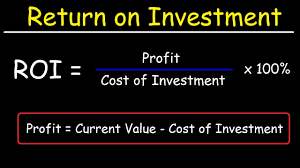Welcome to our comprehensive financial toolkit, featuring the ROI Return on Investment Calculator which is also called Average Annual Return Calculator. Whether you’re a seasoned investor or just starting, our calculators are designed to help you make informed decisions and maximize your returns on investments. These powerful tools will help you evaluate your investment performance, plan your loan repayments, and make informed decisions, empowering you to optimize your financial strategy and secure a prosperous future.
Return on Investment Calculator
What is the ROI?
ROI stands for “Return on Investment” and it’s a crucial metric for determining the profitability of your investment.
In simple terms, ROI is a ratio that measures the amount of return on an investment relative to its cost. It’s a key indicator of the effectiveness of an investment and helps you to understand whether or not it’s worth the investment of time, money and resources.
Calculating ROI is relatively straightforward. To calculate the ROI, you divide the profit by the investment cost and multiply it by 100 to get a percentage. For example, if you invest $1,000 in a campaign and the profit is $1,500, then the ROI would be (1500-1000)/1000 x 100 = 50%.
ROI is an important metric to track for businesses of all sizes. It helps you to identify which investments are paying off and which ones are not. By understanding your ROI, you can make more informed decisions about how to allocate your resources and maximize your profits.
There are many different types of ROI calculators available online that can help you to calculate the ROI for your specific investment. These calculators take into account factors such as the initial investment cost, the expected return, and the time frame for the investment.
In conclusion, ROI is a critical metric for measuring the success of any investment. By calculating your ROI, you can make more informed decisions about where to allocate your resources and maximize your profits.
What is ROI formula?
The ROI formula is:
ROI = (Net Profit / Cost of Investment) x 100%
Net profit is the amount of money you earn from an investment minus the cost of the investment. The cost of investment is the total amount of money you spend on the investment, including any fees or expenses.
Examples of ROI calculation:- if you invest $10,000 in a project and your net profit is $12,000, the ROI formula would look like this:
ROI = ($12,000 / $10,000) x 100% = 120%
This means that your ROI is 120%, or for every dollar invested, you earned $1.20 in return.
The ROI formula can be used for any type of investment, whether it’s a marketing campaign, real estate, or stocks. It’s a powerful tool that helps you make informed decisions about where to allocate your resources and maximize your profits.
Calculating ROI is not only important for measuring the success of an investment, but it can also help you identify areas for improvement. By tracking your ROI over time, you can see which investments are performing well and which ones are not.
What is a difference between ROE vs. ROI?
When it comes to measuring the performance of a business, two key metrics are often used: Return on Equity (ROE) and Return on Investment (ROI). While both metrics are important, they measure different aspects of a business’s performance.
ROE measures the amount of net income generated by a company in relation to the amount of equity invested in the company. It’s calculated by dividing net income by shareholders’ equity. ROE is often used to measure a company’s profitability from the perspective of its shareholders.
On the other hand, ROI measures the amount of return generated by an investment in relation to the cost of that investment. It’s calculated by dividing the net profit of an investment by the cost of the investment. ROI is often used to measure the profitability of a specific investment or project.
The key difference between ROE and ROI is the perspective from which they measure profitability. ROE measures profitability from the perspective of shareholders, while ROI measures profitability from the perspective of a specific investment or project.
ROE is a more long-term measure of profitability, as it takes into account the amount of equity invested in a company over time. It’s often used to evaluate the performance of a company over a longer period of time, such as several years.
ROI, on the other hand, is a more short-term measure of profitability, as it focuses on the performance of a specific investment or project. It’s often used to evaluate the success of a single initiative, such as a marketing campaign or a new product launch.
In conclusion, while both ROE and ROI are important metrics for measuring the performance of a business, they measure different aspects of profitability. ROE measures profitability from the perspective of shareholders over time, while ROI measures profitability from the perspective of a specific investment or project in the short term. Understanding the key differences between ROE and ROI can help you make more informed decisions about where to allocate your resources and maximize your profits.
How can you use ROI in making wise financial decisions?
Here are some tips on how to use ROI in making wise financial decisions:
Define your investment objectives: Before making any investment decisions, it’s important to have a clear understanding of your financial goals. Are you looking to generate a steady stream of income, or are you aiming for long-term growth? By defining your investment objectives, you can evaluate different investment opportunities based on how well they align with your goals.
Analyze potential investments: Once you have a clear understanding of your investment objectives, you can start evaluating different investment opportunities based on their potential ROI. This involves analyzing the expected return on investment, as well as the associated risks and costs.
Consider the time horizon: The time horizon for your investment can have a significant impact on the potential ROI. Short-term investments may generate quick returns, but they may also be riskier and less stable than long-term investments. On the other hand, long-term investments may offer greater stability and potential for growth, but they may also require a larger initial investment.
Evaluate the risk-to-reward ratio: Every investment carries some degree of risk, and it’s important to evaluate the potential risks and rewards of different investment opportunities. A high-risk investment may offer the potential for high returns, but it also carries a greater risk of loss. Conversely, a low-risk investment may offer more stability and security, but it may also generate lower returns.
Monitor your investments: Once you’ve made an investment, it’s important to monitor its performance over time. This involves tracking the ROI, as well as any changes in the underlying market conditions that may affect the investment’s performance.
By using ROI in your decision-making process, you can make more informed and strategic investment decisions that maximize your returns and minimize your risks.
What are the advantages and disadvantages of ROI?
Advantages of ROI:
Helps to make informed investment decisions: ROI provides a clear picture of the potential profitability of an investment. It helps investors to identify the most profitable investment opportunities and make informed investment decisions.
Provides a benchmark for performance measurement: ROI provides a benchmark against which the performance of an investment can be measured. It enables investors to compare the performance of different investments and identify the most profitable ones.
Helps in financial planning: ROI helps in financial planning by providing insights into the potential profitability of an investment. It helps investors to allocate their resources more effectively and plan their finances accordingly.
Easy to calculate: ROI is easy to calculate and provides a simple yet effective way of measuring the performance of an investment.
Disadvantages of ROI:
Ignores the time value of money: ROI does not consider the time value of money, which can be a disadvantage in situations where the investment generates cash flows over a period of time.
Ignores other factors: ROI only considers the financial performance of an investment and ignores other important factors such as the impact of the investment on the environment or society.
Can be misleading: ROI can be misleading if it is calculated using inaccurate or incomplete information. It is important to consider all the relevant costs and benefits associated with an investment to arrive at an accurate ROI.
Does not account for risk: ROI does not account for the risk associated with an investment. An investment with a high ROI may be riskier than an investment with a lower ROI.
Investing recommendations for better ROI
Here are some investing recommendations that can help you achieve a better ROI:
Diversify your portfolio: Diversification is key to managing risk and achieving a better ROI. Investing in a variety of asset classes such as stocks, bonds, real estate, and commodities can help spread out your risk and increase your chances of achieving a better ROI.
Invest in high-growth sectors: Investing in sectors that are experiencing high growth can help you achieve a better ROI. These sectors typically include technology, healthcare, and renewable energy.

Choose quality companies: When investing in individual stocks, it’s important to choose quality companies with a strong track record of growth and profitability. Companies with strong balance sheets, low debt, and a competitive advantage are more likely to achieve a better ROI over the long term.
Follow a disciplined approach: Following a disciplined approach to investing can help you achieve a better ROI. This involves setting realistic investment goals, sticking to a long-term investment strategy, and avoiding emotional investing decisions.
Consider dollar-cost averaging: Dollar-cost averaging involves investing a fixed amount of money at regular intervals, regardless of the current market conditions. This approach can help you achieve a better ROI by buying more shares when prices are low and fewer shares when prices are high.
Take advantage of tax-deferred accounts: Investing in tax-deferred accounts such as 401(k)s and IRAs can help you achieve a better ROI by minimizing your taxes and maximizing your returns over the long term.
Stay informed: Keeping up with the latest market trends and news can help you make informed decisions and achieve a better ROI. Regularly monitoring your portfolio and making adjustments as necessary can help you stay on track and achieve your investment goals.
The Average Annual Return Calculator
Making informed investment decisions is key to achieving financial success and building wealth. Whether you’re a seasoned investor or just getting started, understanding the performance of your investments is crucial. The Average Annual Return Calculator and ROI (Return on Investment) Calculator are valuable tools that provide insights into how your investments are performing. In this article, we’ll delve into the importance of these calculators and how they can help you assess and plan your investments.
Demystifying Average Annual Return:
The Average Annual Return, often referred to as the annualized return or compound annual growth rate (CAGR), is a measure of an investment’s performance over multiple years. It accounts for compounding and volatility, providing a more accurate representation of how an investment has grown or declined.
The ROI (Return on Investment) Calculator:
The ROI Calculator is a financial tool that calculates the return on an investment based on the initial investment amount and the profit or loss generated. It helps investors understand the efficiency and profitability of their investments.
The Role of the Average Annual Return Calculator:
The Average Annual Return Calculator is a powerful tool that allows investors to assess the historical performance of their investments. By analyzing this data, investors can make informed decisions regarding their portfolio’s composition and future investment choices. Here’s how it works:
Input Investment Data: Start by entering the initial investment amount, the final value of the investment, and the investment duration (the number of years). This data forms the basis of the calculation.
Calculate Average Annual Return: The calculator will then use this information to determine the average annual return, considering both gains and losses. The result is typically presented as a percentage, helping you gauge the investment’s performance.
Evaluate Investment Performance: The calculated average annual return provides a clear picture of how well your investment has fared over time. A positive return signifies growth, while a negative return indicates a loss.
Leveraging the ROI Calculator:
The ROI Calculator is a straightforward tool that quantifies the profitability of an investment. Here’s how to use it:
Enter Initial Investment: Begin by inputting the initial amount invested.
Include Profit or Loss: Add the total profit or loss generated by the investment.
Calculate ROI: The calculator will then determine the ROI as a percentage. A positive ROI represents a profitable investment, while a negative ROI indicates a loss.
Why These Calculators Matter:
Both the Average Annual Return Calculator and the ROI Calculator are essential for investors. They provide valuable insights, such as:
Performance Assessment: Investors can evaluate how their investments have performed over time and determine if they meet their financial goals.
Risk Evaluation: By understanding the historical performance and ROI, investors can gauge the level of risk associated with their investments.
Portfolio Diversification: These calculators can help investors assess the need for diversifying their portfolios to balance risk and potential returns.
Decision Making: Armed with the knowledge of their investments’ performance, investors can make informed decisions regarding buying, selling, or holding onto assets.
In Conclusion:
Investing wisely is about more than just choosing the right assets; it’s about understanding how they perform over time. The Average Annual Return Calculator and ROI Calculator are indispensable tools that provide insights into the historical performance and profitability of your investments. Whether you’re managing a diverse portfolio or tracking a single investment, these calculators empower you to make informed decisions, maximize returns, and build a secure financial future.
FAQ on ROI (Return on Investment)
1. What is ROI (Return on Investment)?
- ROI is a financial metric used to evaluate the profitability or performance of an investment. It measures the gain or loss generated relative to the initial investment.
2. How is ROI calculated?
- ROI is calculated by dividing the net profit from an investment by the initial investment amount and then multiplying the result by 100 to express it as a percentage. The formula is (Net Profit / Initial Investment) x 100.
3. What is the significance of ROI in investment decision-making?
- ROI is crucial for assessing the potential returns and risk associated with investments. It helps investors determine whether an investment is worth pursuing or if there are better opportunities available.
4. How does the Average Annual Return Calculator relate to ROI?
- The Average Annual Return Calculator is a tool that calculates the average annual return on an investment over a specified period. ROI is a broader concept that can include the annualized return, but it may also encompass other types of returns, such as total ROI over the investment’s entire life.
5. What are the different types of ROI?
- There are various types of ROI, including total ROI, annual ROI, and return on assets (ROA), among others. The specific type of ROI used depends on the context and the investment being assessed.
6. Can ROI be negative?
- Yes, ROI can be negative, which indicates that the investment resulted in a loss. Negative ROI means that the investment didn’t generate a profit and, in fact, resulted in a reduction of the initial investment.
7. How is ROI used in business decision-making?
- In business, ROI is commonly used to evaluate the profitability of various projects or investments. It helps companies prioritize initiatives and allocate resources to those that offer the best returns.
8. What are some factors that can influence the ROI of an investment?
- Several factors can influence ROI, including market conditions, the timing of the investment, management efficiency, economic factors, and the type of investment itself.
9. Is a high ROI always better than a low ROI?
- A high ROI is generally preferred, as it indicates a more profitable investment. However, it’s essential to consider risk and other factors. A higher ROI may come with greater risk or require a longer investment horizon.
10. Can ROI calculations be used for both short-term and long-term investments?
Yes, ROI calculations can be used for both short-term and long-term investments. Short-term ROI may focus on immediate gains, while long-term ROI considers returns over a more extended period.
11. How does one use the ROI Return on Investment Calculator?
To use an ROI Return on Investment Calculator, you input the initial investment amount and the net profit generated by the investment. The calculator will then provide the ROI as a percentage.
12. Are there industries or investments where ROI calculations are more critical?
ROI calculations are valuable in nearly every industry and for various types of investments. They are particularly crucial in businesses, real estate, stocks, and venture capital, where profitability is a primary concern.
13. Can ROI calculations account for risks associated with an investment?
ROI calculations on their own do not account for risk. However, investors often consider risk-adjusted returns, where ROI is assessed alongside the level of risk associated with the investment.
ROI Return on Investment Calculator – Average Annual Return Calculator – Investment Annual Return Calculator
Legal Notices and Disclaimer
All Information contained in and produced by the ModernCalculators.com is provided for educational purposes only. This information should not be used for any Financial planning etc. Take the help from Financial experts for any Finace related Topics. This Website will not be responsible for any Financial loss etc.





